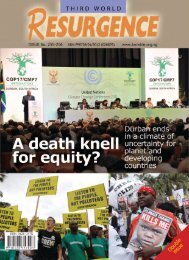Plantations, poverty and power - Critical Information Collective
Plantations, poverty and power - Critical Information Collective
Plantations, poverty and power - Critical Information Collective
You also want an ePaper? Increase the reach of your titles
YUMPU automatically turns print PDFs into web optimized ePapers that Google loves.
12<br />
“Were it not for labour unions at home, we would be moving all of our production capacity to countries<br />
like Brazil,” a Stora Enso official told the Financial Times in 2005. 20 Since 1996, 73 per cent of global<br />
growth in global pulp production capacity has taken place in Brazil, Chile <strong>and</strong> Indonesia. Between 1996<br />
<strong>and</strong> 2003, pulp capacity in North America reduced by 1.6 per cent, while in Latin America capacity<br />
increased by 27.2 per cent <strong>and</strong> in Asia by 76.4 per cent (in Indonesia, capacity increased by a staggering<br />
118.7 per cent over this period). 21<br />
There are several factors that are driving the expansion of the pulp <strong>and</strong> paper industry in the global South.<br />
A key factor is that it is cheaper to produce pulp in the South than in the North. It costs US$120 a tonne to<br />
produce pulp at Veracel’s new pulp mill in Brazil, compared to US$320 in North America <strong>and</strong> US$400 in<br />
Sc<strong>and</strong>inavia. 22<br />
Every year, PricewaterhouseCoopers produces a report on the pulp <strong>and</strong> paper industry. The reports do not<br />
comment on the social impacts of the industry, but they do provide an insight into the motivations of the<br />
industry <strong>and</strong> the reasons for the move to the South. Not surprisingly, it has nothing to do with the<br />
development of countries in the South. It has to do with the requirements of global finance to invest in<br />
new projects <strong>and</strong> the requirements of corporations to make a profit:<br />
“With the suboptimal returns realised by traditional regions (North America, Western Europe <strong>and</strong> Japan)<br />
for several years, investment dollars have been reallocated to the higher return regions of the emerging<br />
markets. This impacts both capital allocation decisions by producers, as well as equity investment<br />
decisions by portfolio managers.” 23<br />
Finl<strong>and</strong>’s economy is heavily dependent on the pulp <strong>and</strong> paper sector. During the late 1980s, an economic<br />
recession in Finl<strong>and</strong> led to heavy losses, cost cutting <strong>and</strong> lay-offs in the forestry industry. “[T]he<br />
deterioration of the Finnish economy is a cause for great concern. It is obvious that if our labour costs<br />
continue to go up faster than in those countries we compete against, our competitiveness will deteriorate,”<br />
Casimir Ehrnrooth, then-chief executive of Finnish company Kymmene told the Financial Times in 1989.<br />
Ehrnrooth’s solution was “going global”, exp<strong>and</strong>ing the company’s operations in the South. 24 In the mid-<br />
1990s, Kymmene merged with Repola Ltd <strong>and</strong> its subsidiary United Paper Mills to form UPM-<br />
Kymmene. The company subsequently exp<strong>and</strong>ed its operations to China <strong>and</strong> Uruguay (through its<br />
subsidiary, Botnia). 25 UPM-Kymmene’s Changsu paper mill in China is supplied with pulp from APRIL<br />
in Indonesia 26 <strong>and</strong> the Botnia pulp mill in Uruguay.<br />
20 Raymond Colitt (2005) “Brazil is top of the tree in tale that is no pulp fiction: Faster-growing wood <strong>and</strong> lower production<br />
costs are luring paper-makers from Europe <strong>and</strong> North America”, Financial Times, 21 June 2005.<br />
21 Machteld Spek (2006) “Financing pulp mills: an appraisal of risk assessment <strong>and</strong> safeguard procedures”, Center for<br />
International Forestry Research (CIFOR), Bogor, Indonesia, page 6.<br />
http://www.cifor.cgiar.org/publications/pdf_files/Books/BSpek0601.pdf<br />
22 Raymond Colitt (2005) “Brazil is top of the tree in tale that is no pulp fiction: Faster-growing wood <strong>and</strong> lower production<br />
costs are luring paper-makers from Europe <strong>and</strong> North America”, Financial Times, 21 June 2005.<br />
23 “Global Forest <strong>and</strong> Paper Industry Survey: 2006 Edition - Survey of 2005 Results”, PricewaterhouseCoopers, 2006, page 5.<br />
24 Enrique Tessier (1989) “Exporters’ cause for concern - Problems for Finnish manufacturers”, Financial Times, 13<br />
December 1989.<br />
25 UPM-Kymmene today has about 100 production facilities in 14 countries. For a detailed history of UPM-Kymmene, see<br />
“Company History: UPM-Kymmene Corporation” Hoover’s Profile. http://www.answers.com/topic/upm-kymmenecorporation-adrcat=biz-fin<br />
26 “UPM-Kymmene <strong>and</strong> APRIL: The Chinese-Indonesian connection”, World Rainforest Movement Bulletin no. 38,















